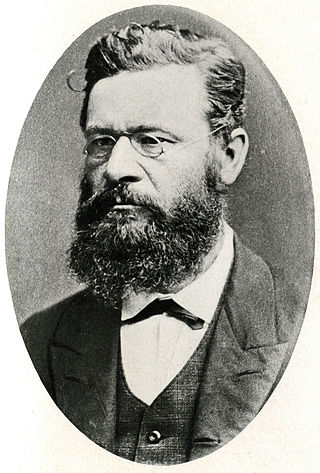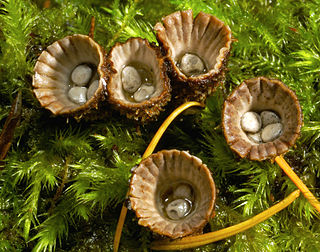Related Research Articles

Mycology is the branch of biology concerned with the study of fungi, including their taxonomy, genetics, biochemical properties, and use by humans. Fungi can be a source of tinder, food, traditional medicine, as well as entheogens, poison, and infection.
Genus is a taxonomic rank used in the biological classification of living and fossil organisms as well as viruses. In the hierarchy of biological classification, genus comes above species and below family. In binomial nomenclature, the genus name forms the first part of the binomial species name for each species within the genus.

The Leotiomycetes are a class of ascomycete fungi. Many of them cause serious plant diseases.

Petter Adolf Karsten was a Finnish mycologist, the foremost expert on the fungi of Finland in his day, and known in consequence as the "father of Finnish mycology".
Hyphochytrids are eukaryotic organisms in the group of Stramenopiles (Heterokonta).

Trimerophytopsida is a class of early vascular plants from the Devonian, informally called trimerophytes. It contains genera such as Psilophyton. This group is probably paraphyletic, and is believed to be the ancestral group from which both the ferns and seed plants evolved. Different authors have treated the group at different taxonomic ranks using the names Trimerophyta, Trimerophytophyta, Trimerophytina, Trimerophytophytina and Trimerophytales.

Alexander Hanchett Smith was an American mycologist known for his extensive contributions to the taxonomy and phylogeny of the higher fungi, especially the agarics.

Cyathus is a genus of fungi in the Nidulariaceae, which is a family collectively known as the bird's nest fungi. They are given this name as they resemble tiny bird's nests filled with "eggs" – structures large enough to have been mistaken in the past for seeds. However, these are now known to be reproductive structures containing spores. The "eggs", or peridioles, are firmly attached to the inner surface of this fruit body by an elastic cord of mycelia known as a funiculus. The 45 species are widely distributed throughout the world and some are found in most countries, although a few exist in only one or two locales. Cyathus stercoreus is considered endangered in a number of European countries. Some species of Cyathus are also known as splash cups, which refers to the fact that falling raindrops can knock the peridioles out of the open-cup fruit body. The internal and external surfaces of this cup may be ridged longitudinally ; this is one example of a taxonomic characteristic that has traditionally served to distinguish between species.

Dirinaria is a genus of lichenized fungi in the family Caliciaceae. The genus has a widespread distribution, especially in tropical regions, and contains about 35 species.
Richard William George Dennis, PhD, was an English mycologist and plant pathologist.

Sistotrema is a genus of fungi in the family Hydnaceae. The genus contains at least 55 species and has a worldwide distribution. The type species is Sistotrema confluens Pers. (1794).

Meinhard Michael Moser was an Austrian mycologist. His work principally concerned the taxonomy, chemistry, and toxicity of the gilled mushrooms (Agaricales), especially those of the genus Cortinarius, and the ecology of ectomycorrhizal relationships. His contributions to the Kleine Kryptogamenflora von Mitteleuropa series of mycological guidebooks were well regarded and widely used. In particular, his 1953 Blätter- und Bauchpilze [The Gilled and Gasteroid Fungi ], which became known as simply "Moser", saw several editions in both the original German and in translation. Other important works included a 1960 monograph on the genus Phlegmacium and a 1975 study of members of Cortinarius, Dermocybe, and Stephanopus in South America, co-authored with the mycologist Egon Horak.
Fischerula is a genus of two truffle-like fungi in the family Morchellaceae. First described from central Italy by Oreste Mattirolo in 1928, the genus name honors Swiss mycologist Eduard Fischer. The type species Fischerula macrospora is known only from Italy, while Fischerula subcaulis is found in coniferous and mixed forests of Oregon and Washington.
Amanita zambiana, commonly known as the Zambian slender Caesar, is a basidiomycete fungus in the genus Amanita. An edible mushroom, it is found in Africa, where it is commonly sold in markets.

Albert Pilát was a Czech botanist and mycologist. He studied at the Faculty of Science at Charles University, under the guidance of Professor Josef Velenovský. In 1930, he joined the National Museum, eventually becoming head of the Mycological Department, and in 1960 a corresponding member of the academy. He was the author of many popular and scholarly publications in the field of mycology and mountain flora. He also served as the main editor of the scientific journal Czech Mycology, and described several species of fungi. His areas of particular interest include polypores and boletes. He explored the Carpathians looking for fungi and travelled widely. He was also a skilled photographer.
References
- ↑ Jülich W. (1975). "Studies in resupinate basidiomycetes – III". Persoonia. 8 (3): 291–305.
- ↑ Kirk PM, Cannon PF, Minter DW, Stalpers JA (2008). Dictionary of the Fungi (10th ed.). Wallingford, UK: CAB International. p. 417. ISBN 978-0-85199-826-8.